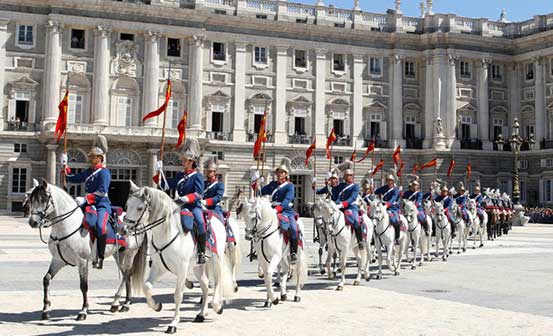
It is not for nothing that Madrid, the Spanish capital is known far and wide for its good and vibrant La Vida (life) which every visitor looks forward to.
Madrid has everything that a visitor looks out for in Europe — interesting places to go for sight-seeing, tapas bars, plenty of football and an exciting nightlife that is always talked about around the world.
It is now carnival time with the streets of Madrid’s Tetuan district is filled with people enjoying the city’s popular five-day extravaganza which ends on 10 February.
This year’s carnival pays tribute to jesters who bring a smile and induce laughter in the lives of people.
The fun and frolic at this event lifts the spirits of all those taking part in the event.The procession has dancers gyrating to the tunes of bands from Senegal, Paraguay, Peru, Colombia, Dominican Republic and Brazil.
The carnival gives an interesting peep into Spanish culture.
There is without doubt a lot to see in Madrid and they give an insight into the origins of the historical city.
Spain is the home of bullfighting and Madrid is famous for its shows. The city’s main bullring is called Les Ventas and is the third largest in the world after those of Mexico and Venezuela.
This massive bullring is in the Guindalera area in the northeast of Madrid. The best time to experience the two-hour spectacle is during the San Isidro Festival between May and June. That is when the most famous bullfighting festival in the world takes place.
To get to enjoy more in Madrid, take the series of guided tours through which you will get know the city’s oldest vestiges, legends, anecdotes and history merging together in a magical atmosphere.
I would have been lost if I did not have a guide as Madrid is a sprawling city. It was a joy discovering the most emblematic spots like the Santiago neighbourhood in the Latina area and Plaza de Oriente. Places like Plaza de la Paja and Plaza de la Villa take you back to medieval times.
The heart of Madrid is worth exploring so that you can discover the city’s hidden gems.
Peurta Del Sol is known for the top personalities linked with it — such as the “Major King” Charles III whose statue faces the city with pride.
Literature has a special place of price with the Spanish. Barrio de las Letras or Letters Quarter highlights the greatest writers — Lope de Vega, Cervantes and Quevedo who lived in the neighbourhood.
Stay informed. Subscribe to our newsletter
The Prado Museum nearby is one of the greatest in the world. It is one of Madrid’s most visited attractions. Its walls are lined with masterpieces from Spanish, Italian and Flemish schools including Goya’s Third of May 1808. It has a vast collection of 8,600 pieces and over 700 sculptures which simply cannot be covered with one visit.
One of the city’s most charming districts is the Plaza Mayor, a portico-lined square in the heart of Hapsburg Madrid.
My guide Alberto Miguel said before Madrid became the capital, it had narrow winding streets, alleyways with swashbuckling swordsmen and medieval rogues on the loose! But today the city boasts wide avenues and boulevards.
The foundations of Plaza Mayor were laid in the 15th century when Philip II moved his court to Madrid, on the site of the former Plaza del Arrabel, the site of the town’s most popular market.
Today this is a wonderful place to enjoy so many attractions. Some of the best buildings can be seen here.
Madrid is the world capital of the popular flamenco dance which is now a universal cultural heritage. Enjoy memorable moments of an evening at special flamenco clubs or the city’s tablaos as you savour a spine-tingling experience with emotion as you hear and watch flamenco in its purest state.
Flamenco is actually a form of communication — an art that has been passed down generations. As you sit comfortably, the silence is suddenly broken with the strumming of a guitar, a lament, heels tapping or a muffled half clap reverberating on the stage in its much-loved traditional offering.
It has lots of passion, inspiration and a unique technique only found in Spain.
Flamenco dancers wear the Traje de Volantes — an ankle-length tight-fitting, polka-dotted dress with a flounced skirt and flounced sleeves, originally worn by gypsy women.
The weekly changing of the guard at the Royal Palace is also worth a visit. You have to get there very early for the best spot to see this colourful event.
The steps leading to the La Amuden Cathedral are packed out long before the event starts.As the clock chimes each Wednesday the horses can be heard trotting in the distance and the Changing of the Royal Guard starts. The hour-long event involves 100 horses and 400 soldiers including lancers and mounted soldiers.
The Rastro Market in the La Latina District holds a place of pride in historical Madrid.
Full of locals and visitors on Sundays and public holidays, this market in Plaza de Cascorro, houses 1,000 vendors offering enticing choices of crafts, clothes and amazing trinkets from various periods.
Apart from Madrid, Spain has lot of holiday beach resorts such as Cantabria, Costa Brava, Costa Blanca, Majorca, Menorca, Costa del Almeria, Costa del Sol, Canary Islands and the Balearic islands.
 The Standard Group Plc is a
multi-media organization with investments in media platforms spanning newspaper
print operations, television, radio broadcasting, digital and online services. The
Standard Group is recognized as a leading multi-media house in Kenya with a key
influence in matters of national and international interest.
The Standard Group Plc is a
multi-media organization with investments in media platforms spanning newspaper
print operations, television, radio broadcasting, digital and online services. The
Standard Group is recognized as a leading multi-media house in Kenya with a key
influence in matters of national and international interest.
 The Standard Group Plc is a
multi-media organization with investments in media platforms spanning newspaper
print operations, television, radio broadcasting, digital and online services. The
Standard Group is recognized as a leading multi-media house in Kenya with a key
influence in matters of national and international interest.
The Standard Group Plc is a
multi-media organization with investments in media platforms spanning newspaper
print operations, television, radio broadcasting, digital and online services. The
Standard Group is recognized as a leading multi-media house in Kenya with a key
influence in matters of national and international interest.










